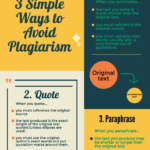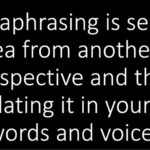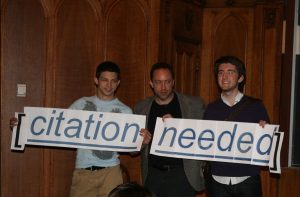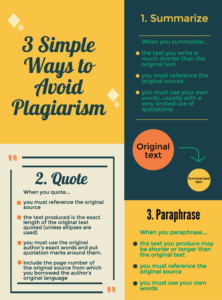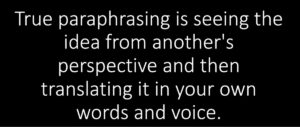For writers, learning how to cite sources in academic and professional writing is twofold: one aspect is rule-bound and procedural, while the other is open-ended and creative:
- Citation refers to a set of conventions for weaving the ideas and words of others into your writing
- Communities of practice — such as The APA – American Psychological Association or the MLA – The Modern Language Association — develop unique textual practices — including conventions for acknowledging, quoting, paraphrasing, and summarizing sources
- Citation refers to an act of composing – — the act of synthesizing your voice and ideas with the voices and ideas of others. Writers decide sources they want to cite during composing as they
- research the status of the scholarly conversation on any particular topic among domain experts (e.g., scholars, researchers and practitioners)
- engage in rhetorical analysis (especially audience analysis) to determine the reader’s expectations regarding citation, media, genre, voice–and related matters
- realize, through drafting, what it is they want to say — and, consequently, whom they need to cite.
Key Concepts: Academic Dishonesty; Attribution; Evidence; Information, Data; Archive; Epistemology; Plagiarism; Textual Research; Symbol Analyst; The CRAAP Test
Introduction
Citation — the act of informing your audience when you integrate material into your work that originates from another source — is both (1) a procedural, rule-bound process and (2) a creative act.
Citation as a Procedural, Rule-bound Process
First and foremost, citation functions as a methodical, rule-driven process, where adhering to the conventions of specific citation styles is paramount. For instance, if you are a scientist attempting to publish an article in The New England Journal of Medicine, you would need to follow the ICMJE Recommendations or the Vancouver system to ensure your references are correctly formatted and accepted by the journal’s editors.
This procedural aspect of citation can be broken down into four main steps:
- Determine the Citation Style: Understand the specific citation style your assignment or publication demands, be it APA, MLA, Chicago, or others.
- Choose Your Citation Strategy or Tool: Opt for a strategy or citation tool to systematically track and organize your citations.
- Compose Citations: Ensure accurate representation for all material borrowed from other sources, be it summarized, paraphrased, or quoted.
- Review and Revise: As your work develops, rigorously verify that your citations — in-text (parenthetical, numbered, or note citations, and in the reference list — conform to the requirements of the required citation style.
For a deeper understanding of these basic steps, consult the following:
- Citation – When & Why You Must Cite Sources in Academic & Professional Writing
- Paraphrase – Definition & Examples – How to Paraphrase with Clarity & Concision
- Quotation – When & How to Use Quotes in Your Writing
- Summary – How to Summarize Sources in Academic & Professional Writing
Citation as a Creative Act
Beyond the specific conventions dictated by formats like APA or MLA, citation is fundamentally about joining an ongoing dialogue with fellow scholars, past and present. Thus, beyond being rule-bound, citation is also a rhetorical, creative act.
When writers summarize, paraphrase, or quote others, they’re not just borrowing words or thoughts. Instead, they’re actively positioning themselves within a broader, dynamic conversation that encompasses centuries of human thought and inquiry. Take, for instance, the act of referencing Michelle Alexander’s “The New Jim Crow”. Citing Alexander’s work is akin to stepping into an expansive auditorium, catching Alexander’s eye, and confidently contributing to a resounding, layered discussion. Happily, in attendance at the auditorium are all of the writers that Alexander quoted — and all of the authors those writers cited. And, streaming in the door are new authors who are eager to add their two cents to the conversation.
Here’s the bottom line: human nature instinctively pushes us toward collaboration and the sharing of knowledge. Across history, great thinkers have acknowledged and celebrated this collective instinct.
The Association of College and Research Libraries reinforces this through their “Scholarship as a Conversation” framework. They posit that knowledge isn’t just a treasure waiting to be discovered but an ongoing dialogue to be engaged with. Within this context, citation isn’t just a formality; it’s an essential tether, anchoring our ideas to the vast mosaic of scholarly exchange.
Historical reflections affirm this communal approach to knowledge. Bernard of Chartres, in 1159, coined the metaphor of “dwarves perched on the shoulders of giants,” emphasizing our continuous build on the foundational work of predecessors. Similarly, Isaac Newton, in 1675, noted that his groundbreaking discoveries were possible due to the insights of those before him. In turn, Kenneth Burke’s ‘parlor metaphor’ offers a vivid portrayal of this timeless academic exchange. He likens it to a conversation that’s been underway long before we join in and will continue long after we’ve departed, with new voices continually enriching the discourse.
Today, platforms like Google Scholar echo this enduring philosophy, with its motto, “Stand on the shoulders of Giants.” It serves as a reminder that as we wade through the extensive realm of human understanding, citation acts as our guiding star – enabling us to both find our way and add our unique insights to humanity’s unending scholarly conversation.
FAQs
How Can I Determine Which Citation Style to Use?
Each community of practice adopts its own discourse conventions for citation. For instance, a paper written for an English course might expect citations to follow the Modern Language Association (MLA) style, while a psychology research article would typically utilize the American Psychological Association (APA) format. Similarly, a historian might lean towards the Chicago Manual of Style. Thus, there isn’t a one-size-fits-all approach to incorporating sources into your writing.
Thus, your first step when endeavoring to weave the ideas and words of others into your writing is to engage in rhetorical analysis:
- What citation format does your audience anticipate? This often hinges on the academic discipline, publication venue, or even a specific instructor’s preference.
- Do your readers prefer direct quotations, paraphrases, or a mix of both?
- How frequently do they expect sources to be cited?
- Are primary sources prioritized over secondary ones?
Is Using a Citation Tool a Good Idea?
Yes! Utilizing a citation tool scugh as Zotero can greatly benefit students and professionals alike for several reasons:
- Efficiency and Consistency: These tools automate the creation of citations and ensure consistency across all references, which is especially beneficial when handling multiple sources.
- Accuracy: Many citation tools extract data directly from journals, databases, or websites, which minimizes potential human errors in capturing details such as authors, publication dates, or titles.
- Adaptability: One of the notable benefits of citation tools is their ability to quickly switch between various citation styles. This is invaluable if you’re writing assignments for different courses or if you’re publishing in diverse venues with distinct citation requirements.
- Archival and Organizational Benefits: Citation tools store and organize references, providing a valuable archive of your reading history. This not only helps you keep track of sources you’ve read but also leverages your reading history to aid in future research or writing projects. The ability to categorize, tag, and annotate references can be a game-changer for extensive research projects.
- Cross-Platform Synchronization: Many citation tools synchronize across devices and platforms. This means you can access, add to, or edit your library from any device, ensuring seamless integration into your workflow.
When Should I Directly Quote a Source Versus Paraphrasing or Summarizing It?
Use a Direct Quote:
- When Original Phrasing is Important: Some authors have a unique way of expressing thoughts that can’t be recreated without losing its essence. If a particular turn of phrase or specific words are crucial, retain them.
- When It Supports Your Point Strongly: If a quote directly aligns with your argument and bolsters it more than a paraphrase or summary would, opt for a direct quote.
- For Credibility: Quoting renowned experts or primary sources can lend your work credibility. Direct quotes serve as evidence that your claims are rooted in established research or authoritative opinions.
- To Personalize Information: Paraphrasing allows you to present information in your voice. This not only showcases your understanding but ensures the information seamlessly blends with your narrative.
- To Simplify Complex Content: Some original texts may be laden with jargon or complex structures. Paraphrasing can distill these intricate concepts into more accessible language. It’s an opportunity to break down and explain content, making it easier for your audience to grasp.
- Providing an Overview: When you need to touch upon the general themes or major points of a large body of work without diving deep into specifics, summarizing is your go-to tool.
- Condensing Information: Summarizing is especially useful when dealing with lengthy sources. It allows you to present the core ideas succinctly, giving readers a snapshot of the content without overwhelming them with details.
How Can I Distinguish My Ideas from Those of My Sources?
It’s essential that writers neither claim others’ ideas as their own (which is plagiarism) nor allow their original thoughts to be overshadowed by external sources. To ensure clarity for your readers, you must differentiate between your ideas and those of your sources.
Readers, moving from left to right, shouldn’t have to double back to figure out the origin of the information in a paragraph or section. Take Theresa Lovins’s essay, “Objectionable Rock Lyrics”, as an instance:
“Many Americans fear government intervention when it comes to human rights. They fear that government censorship of rock lyrics might lead to other restrictions. Then too, what would the guidelines be, who would make these decisions, and how might it affect our cherished constitutional rights? Questions like these should always be approached with serious consideration. We have obligations as parents to protect our children and as Americans to uphold and protect our rights. Therefore, it’s important to ask what effects proposals like Tipper Gore’s, president of PMRC, might have on our freedoms in the future. She recommends that the record companies utilize a rating system: X would stand for profane or sexually explicit lyrics, V for violence, O for occultism, and D/A for drugs/alcohol. The PMRC also suggest that the lyrics be displayed on the outside cover along with a general warning sticker which perhaps might read “Parental Guidance: Explicit Lyrics.” To date, record companies have not agreed to all these demands but some have decided to put warning labels on certain questionable albums (Morthland).”
While Lovins provides complete documentation for her source (i.e., Morthland), she doesn’t clearly delineate what precisely she’s borrowing from him. This ambiguity could be effortlessly addressed with a transitional phrase, such as, “In a recent examination of this controversy, John Morthland’s essay in High Fidelity notes that Tipper Gore has proposed…”. By doing so, Lovins ensures her audience knows exactly where her own thoughts conclude and Morthland’s begin.
First-time Introductions:
- It’s crucial to mention the author’s full name and the title of their work the first time you reference them. This contextualizes the information for your audience and ensures the source’s credibility is apparent.
- MLA Style Example: “Before exploring the intricacies of cultural hybridity, it’s valuable to understand Homi Bhabha’s viewpoint. In The Location of Culture, he notes that mimicry often renders “the colonial subject… as a ‘partial’ presence” (Bhabha 123).”
- APA Style Example: “When assessing cultural hybridity, Bhabha (1994) in his seminal work, The Location of Culture, suggests that mimicry can make “the colonial subject… a ‘partial’ presence” (p. 123).”
Subsequent References:
- After the initial introduction, you can frequently refer just to the author’s last name. Only revert to the full reference if there’s ambiguity or if you’re switching to another work by the same author.
- Example: “As the discussion progresses, Bhabha (1994) further unpacks the intricate dynamics of post-colonial identities, emphasizing the transformative potential of hybrid cultures.”
Key Points to Remember:
- Clarity is Essential: Your audience should always be aware of whose perspective is being presented: yours or a cited source. Proper introductions and references prevent any mix-ups.
- Signposting is Beneficial: Using verbs like “claims,” “asserts,” or “proposes” acts as indicators that the ensuing information is from a cited work.
- Your Voice is Vital: Although external sources bolster your content’s credibility, your personal interpretations, analysis, and synthesis are what set your work apart. Make sure to regularly interject with your perspectives or evaluations of the cited material.
Why Should I End a Paragraph in My Own Voice Instead of a Quote or Paraphrase?
Your paper’s primary voice should be yours, highlighting your unique perspective and contributions. While it’s essential to support your claims with reliable evidence, the primary voice guiding the conversation should be yours. Each paragraph should start and conclude with your insights, ensuring your narrative remains central.
So, how can you, as a writer, effectively conclude a paragraph in your own voice?
- Echo key terms from the quotation or paraphrase in your concluding sentences.
- Identify connections between your viewpoint and the cited content.
- Align the quotation or paraphrase with the overarching aim of the paragraph or your main thesis.
- Draw from the source to craft a smooth transition to the subsequent paragraph.
Illustrative Example:
Main Point: The presence of plastics is ubiquitous in America, yet only a fraction are recycled.
Quotation: “In 2023, merely 8% of the entire plastic waste was redirected for recycling” (“Plastics”).
Initial Paragraph:
Every day, recyclable plastic items surround us. Found in shopping malls, restaurants, offices, schools, or homes, these plastics come as shopping bags, packaging, containers, and more. The choice arises: trash or recycle? The Environmental Protection Agency (EPA) underscores, “only 8% of the total plastic waste generated in 2023 was recovered for recycling” (“Plastics”).
Drawback: The paragraph halts suddenly with the EPA’s statement.
Improved Conclusion:
This figure indicates that most of the plastic waste in 2023 remained unrecycled in America. Addressing this sizable non-recycling demographic with targeted campaigns might be the next strategic step.
Citations:
MLA: “Plastics.” EPA. U.S. Environmental Protection Agency, 16 Apr. 2023. Web. 26 Apr. 2023.
APA: U.S. Environmental Protection Agency. (2023). Plastics. www.epa.gov/plastics.
What’s the Difference Between a Primary and a Secondary Source, and How Might I Approach Integrating Each Into My Writing?
Understanding the distinction between primary and secondary sources is foundational for both academic and professional writing. These sources form the underpinning of our arguments and narratives. For instance, while a comprehensive report may state thousands are affected by an issue, often it’s the personal account of an individual that resonates profoundly with readers.
1. Definitions:
- Primary Source: Direct or firsthand evidence about an event, object, person, or work of art.
- Examples: Original documents (e.g., diaries, letters), raw data, artworks, and interviews.
- Secondary Source: Discussions, interpretations, analyses, or evaluations based on primary sources.
- Examples: Articles, books, or documentaries that critique or comment on primary sources; literature reviews.
2. Strengths of Each Source:
Primary Sources:
- They offer firsthand, unvarnished insights.
- Allow readers to engage directly with raw evidence.
- Provide an authentic voice to a narrative.
Secondary Sources:
- They are part of the written archive, allowing other researchers to validate and engage with the information.
- Provide synthesized views, amalgamating various primary sources.
- Offer expert interpretations, shedding light on complexities and nuances.
3. Approaching Integration:
Primary Sources:
- Contextualize: Describe the broader setting or circumstances of the primary source. For a diary entry, detail the societal backdrop and key events of that time to anchor readers.
- Analyze: Examine the material’s themes, biases, and underlying messages, and explain its relevance to your argument.
Secondary Sources:
- Reference Correctly: Given their place in the written archive, ensure bibliographic information is accurate so others can trace back to the original source.
- Discuss Specific Interpretations: When using a secondary source, highlight its unique perspective or analytical approach. For instance, if referencing a book review that offers a novel interpretation of a classic work, explain this viewpoint and its significance.
4. Balancing the Two:
The manner in which you integrate primary and secondary sources is influenced by the genre of your writing and the rhetorical strategies you’re employing:
- Purpose and Genre: If you’re writing a case study or ethnography, the genre itself dictates a heavier reliance on primary data, giving voice to firsthand experiences. Contrastingly, a literature review or meta-analysis would lean more on secondary sources to map out existing scholarship on a topic.
- Rhetorical Impact: Primary sources, with their raw and unmediated essence, can be powerful tools for ethos and pathos, grounding your narrative in authenticity and evoking emotional responses. Secondary sources, on the other hand, can bolster logos, providing scholarly depth, breadth, and validation to your claims.
- Crafting a Cohesive Narrative: Seamlessly weaving in primary and secondary sources isn’t just about juxtaposing raw data with textual research. It’s about crafting a narrative where each type of source complements the other. A quote from an individual might be the heart of your argument, but the scholarly discussions surrounding that quote give it context and broader significance.
How Can I Effectively Connect My Claims with Sourced Evidence?
Connecting your claims with sourced evidence is pivotal in academic and professional writing. It not only fortifies your arguments but also ensures that your readers understand the relevance of the evidence you’re providing.
1. Avoid Assumptions: Many writers think the relationship between their claim and the evidence is obvious. However, readers might not see the link as clearly. Hence, after presenting sourced material, always explain its significance to your point, purpose, and thesis.
2. Make Direct Connections: Consider the reader as someone who isn’t familiar with your topic. This means after introducing a quote or data, bridge it to your argument.
- Break down ideas: Take the core essence of the sourced material and relate it to your claim.
- Example: Palin suggests most of our oil is sourced from unstable regions. While this concern is valid, we believe offshore drilling poses a bigger economic risk.
- Connect back to the thesis or main point: Relate the evidence to your central argument or the specific point of your paragraph.
- Example: Although Palin’s viewpoint underscores the significance of domestic oil production, it doesn’t consider the environmental risks associated with offshore drilling.
- Highlight your purpose: Clearly state what your intentions are with the evidence.
- Example: Despite arguments favoring offshore drilling, our stance is that its potential hazards far outweigh the benefits.
3. Engage with the Source:
- Explain the importance: Clarify why the sourced material is vital to your argument. Don’t assume the reader grasps its significance.
- Talk back to the source: Showcase your understanding and use it to bolster your stance.
- Discuss the implications: Dive into the consequences of your argument in light of the sourced material.
Ultimately, the goal is to ensure the reader comprehends how the evidence supports, complicates, or even challenges your claims. Remember, you’re not just citing sources; you’re weaving them into your narrative, making your arguments robust and nuanced.
APA Example: Flower and Hayes (1981) argue that many writers view writing as a “serendipitous experience, an act of discovery” (p. 286). This notion underscores the unpredictable nature of the writing process and suggests that exploring various writing methods can be a journey of discovery in itself.
MLA Example: According to Flower and Hayes, many authors perceive writing as “a serendipitous experience, an act of discovery” (286). This perspective highlights the evolving nature of writing, emphasizing the need to embrace diverse writing techniques.
How Can I Show the Relevance or Credibility of a Source to My Readers?
When you’re crafting an argument or presenting information, the strength and credibility of your sources are paramount. Especially in an academic or professional setting, readers seek evidence that’s not only compelling but also credible. Here’s how you can underscore the relevance and credibility of your sources:
- Highlight the Author’s Expertise:
When referring to a notable author, highlight their qualifications and achievements in the relevant field. If you’re discussing the topic of grit and perseverance in writing and citing Angela Duckworth, an esteemed psychologist and author known for her work on this topic, leverage her credentials.
Example: “Angela Duckworth, a celebrated psychologist and the author of Grit: The Power of Passion and Perseverance, argues that grit is a more significant predictor of success than talent.” - Detail the Source’s Pedigree:
The origin of your source can serve as a testimony to its authority.- Publication Type: University presses, often associated with established academic institutions, are generally held in higher regard compared to trade presses or self-publishing platforms like Amazon. This is because university presses often undergo rigorous peer- review processes.
- Journal Credibility: Is the journal you’re citing from peer-reviewed? Peer-reviewed journals maintain a stringent evaluation process where experts in the field review articles before publication. Journals published by professional societies, like the American Psychological Association, often carry weight due to their association with established experts in the field.
- Journal Rankings: In many professions, journals are ranked based on factors like citation rates and impact factor. Quoting from a top-tier journal can add gravitas to your argument.
Example: “A recent study published in The Journal of Positive Psychology, a peer-reviewed journal ranked among the top 10 in the field, supports Duckworth’s theory…”
- Prioritize Recent Sources (When Applicable):
In rapidly evolving subjects like technology or health, the currency of your source can attest to its relevance. Example: “In her 2023 Ted Talk, Duckworth updated her theory on grit by introducing…” - Demonstrate How the Source Augments Your Argument:
Seamlessly connect your source’s assertions to the point you’re underscoring. Example: “Duckworth’s emphasis on sustained effort aligns with studies on successful writers who, despite initial setbacks, persisted and improved over time.” - Address Potential Bias:
By identifying any inherent bias in your source, you enhance your credibility as a discerning researcher. Example: “Although the research was funded by the National Writers’ Association, its findings resonate with independent studies conducted at institutions like Yale and Cambridge.” - Cross-reference with Other Credible Sources:
Support from multiple authoritative sources reinforces the credibility of a point. Example: “This perspective on grit isn’t limited to Duckworth. Both The Journal of Educational Psychology and articles from the British Psychological Society have echoed similar findings.” - Recognize Limitations:
Accepting and indicating the limitations of a source showcases a balanced approach. Example: “Duckworth’s research, while pioneering, focuses mainly on students and educators. It’s essential to consider its applicability to writers from diverse backgrounds and experiences.”
Can I Ever Integrate a Source Without Directly Citing It in the Text? If So, How?
It’s essential to give credit to sources to maintain the integrity of your work and avoid plagiarism. While in-text citations are a direct way to do this, there are other methods to reference sources more discreetly:
- Endnotes or Footnotes: Some documentation styles permit the use of endnotes or footnotes instead of in-text citations. This method prevents the main body of your text from being disrupted by citations. Instead, you’d insert a superscript number that leads to a note at the end of your paper (endnote) or the bottom of the page (footnote) with the source’s full details.
Example: You might write, “Grit, a combination of passion and perseverance, plays a significant role in achieving long-term goals[^1].” The corresponding note would provide the full citation for Angela Duckworth’s work on grit. - General Bibliography/Works Cited: If you’ve integrated overarching ideas from a source, like Duckworth’s foundational theories on grit, but haven’t quoted or paraphrased a specific section, you might not need an in-text citation. Instead, Duckworth’s work would appear in a general bibliography or works cited page, signaling its influence on your understanding.
- Indirect Citations: There may be times when you encounter a perspective on Duckworth’s work cited in another author’s study. If you can’t access Duckworth’s original material, you can reference the intermediary source. Your citation method will vary depending on the documentation style.
Example (in APA style): A recent interpretation of Duckworth’s theory, as discussed by Thompson (2022), suggests… - Paraphrasing Broad Ideas: If you’re referring to widespread knowledge, like the basic definition of grit, you might not need an in-text citation. However, if you’re diving into detailed theories or unique interpretations specific to Duckworth, a citation is essential.
What about Newspapers & Magazines?
Mainstream publications, such as The New York Times or renowned magazines, adopt a different approach to referencing than scholarly or professional works. In these outlets, formal citation methods typical of academic journals aren’t always employed. Instead, there’s a general assumption that these publications have undergone a comprehensive editorial process, ensuring the information’s credibility. A key component of this process is the understanding that if readers or other stakeholders have questions regarding the sources of specific information, they can reach out to the author or publication directly to request these details. Thus, when you use information from such outlets in your writing, it’s essential to maintain this practice: always be prepared to direct readers to your primary source if questioned.
If I’m Reviewing Someone’s Research, How Much Detail Should I Provide about Their Research Methods?
If I’m Reviewing Someone’s Research, How Much Detail Should I Provide About Their Research Methods?
When reviewing another’s research, especially in academic or professional settings, it’s essential to strike a balance. You want to provide enough detail so readers can assess the study’s validity and relevance without overwhelming them with minutiae. The amount of detail needed can depend on your audience, the nature of the study, and the context in which you’re discussing it.
Consider the Purpose of Your Review:
- For Broad Overviews: When discussing the general findings of a study for a more general audience, a brief mention of the methods might suffice. E.g., “In her research on grit, Angela Duckworth conducted extensive surveys across diverse groups, finding a significant correlation between grit and long-term success.”
- For In-depth Analyses or Critiques: If you’re critiquing the study’s methodology or comparing methodologies across studies, you’ll need to delve deeper. E.g., “Duckworth’s study used a five-point Likert scale to measure respondents’ perseverance and passion for long-term goals, a decision that some researchers have debated due to potential response biases.”
- For Replication or Further Studies: If the aim is to allow others to replicate the study or to build upon it, every detail becomes vital, from the sample size to the statistical tests used.
Tips for Detailing Research Methods:
- Highlight Key Components: Describe the research design (e.g., longitudinal, experimental), the participants (sample size, demographics), the tools used (e.g., surveys, interviews), and the analysis methods (e.g., statistical tests, coding procedures).
- Address Potential Biases: For more critical reviews, discuss any potential sources of bias or limitations in the study. Was the sample representative? Were there any confounding variables?
- Compare with Other Studies: If relevant, compare the methods used in the research you’re reviewing with those of other similar studies. This can help readers gauge the study’s uniqueness or reliability.
- Use Visual Aids: Charts, tables, or diagrams can be beneficial in summarizing complex methods or when comparing methods across multiple studies.
For most college-level papers or articles, it’s advisable to include a clear and concise description of the research methods, allowing readers to gauge the study’s reliability and relevance to your discussion or argument. As you become more familiar with your audience and their expectations, you’ll develop a sense for the right level of detail to include.
How Do I Handle Sources From Non-Traditional Mediums, Like Podcasts, Tweets, or YouTube Videos?
In the digital age, research isn’t limited to books, journals, or articles. Multimedia platforms offer rich content that can be invaluable for your work. However, citing these non-traditional mediums can feel a bit daunting. Here’s a guide on how to navigate this terrain:
1. Podcasts:
MLA:
- Host(s) of the episode.
- “Title of the episode.”
- Name of the podcast,
- Production company or publisher,
- Date of publication.
- Platform (if applicable).
- URL.
Example (in MLA style): Duckworth, Angela, host. “The Power of Grit.” Character Lab, Character Lab, 6 June 2021, characterlab.org/podcast/.
APA:
- Host(s) of the episode (Year, Month Day of publication).
- Title of the episode (No. episode number) [Audio podcast episode].
- In Name of the podcast.
- Production company or publisher.
- URL.
Example (in APA style): Duckworth, A. (Host). (2021, June 6). The Power of Grit (No. 23) [Audio podcast episode]. In Character Lab. Character Lab.
2. Tweets:
MLA:
- Author (individual or organization).
- Full text of the tweet.
- Twitter, Date of the tweet.
- URL.
Example (in MLA style): Duckworth, Angela [@angeladuckw]. “Delving deeper into the nuances of grit and determination…” Twitter, 15 February 2022, twitter.com/angeladuckw/status/xxxxxx.
APA:
- Author (Year, Month Day of tweet).
- Full text of the tweet (up to the first 20 words) [Tweet].
- Twitter.
- URL.
Example (in APA style): Duckworth, A. [@angeladuckw]. (2022, February 15). Delving deeper into the nuances of grit and determination… [Tweet]. Twitter. https://twitter.com/angeladuckw/status/xxxxxx
3. YouTube Videos:
MLA:
- Author(s) or creator(s) (individual, group, or organization).
- “Title of the video.”
- YouTube,
- Date of publication.
- URL.
Example (in MLA style): Duckworth, Angela. “Exploring Grit in Education.” YouTube, 1 September 2021, www.youtube.com/watch?v=xxxxxx.
APA:
- Author (Year, Month Day of publication).
- Title of the video [Video].
- YouTube.
- URL.
Example (in APA style): Duckworth, A. (2021, September 1). Exploring Grit in Education [Video]. YouTube. https://www.youtube.com/watch?v=xxxxxx
Notes:
- Citation formats might slightly change based on specific style guide versions or nuances. Always consult the relevant style guide.
- While MLA traditionally doesn’t include URLs, modern editions have adapted to the digital age by including them. Check with your instructor or publication’s preference.
How Do I Cite a Source That Was Quoted by Another Author I’m Reading?
When you come across a situation where you want to cite a quotation or idea that your primary source (the source you’re reading) has taken from another source (the original source), this is known as a secondary or indirect citation. It’s always preferable to locate the original source and cite from it directly; however, there are instances where this may not be feasible. In such cases, you’ll need to provide a citation that acknowledges both the primary and the original sources.
Here’s how you can handle secondary or indirect citations in both APA and MLA styles:
APA: When citing a source you found in another source, name the original author within your sentence, but follow it with “as cited in” and then immediately use the author, publication date, and page number (if available) of the secondary source in your parenthetical citation.
Example: Let’s say you’re reading a book by Thompson (2022) in which he quotes Duckworth (2007). You want to use Duckworth’s quote, but you can’t access her original work. Your in-text citation would look something like this:
Duckworth (2007, as cited in Thompson, 2022, p. 56) asserts that “grit is a combination of passion and perseverance.”
In your reference list, you would only include the secondary source, Thompson’s book, since that’s the source you actually read.
MLA: In MLA style, you’ll indicate the quote’s indirect nature in the in-text citation by using the phrase “qtd. in” (short for “quoted in”).
Example: Using the same scenario, your in-text citation would look like this:
Duckworth asserts that “grit is a combination of passion and perseverance” (qtd. in Thompson 56).
On your Works Cited page, you would only include a full citation for Thompson’s book, the secondary source you consulted.
Remember, using secondary citations should be an exception rather than the rule. Whenever possible, always try to consult and cite the original source directly to ensure the accuracy and context of the information.


